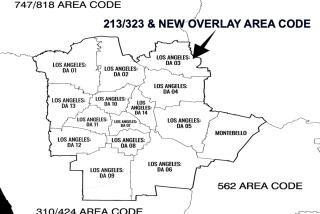With New Pac Bell Yellow Pages, Fingers Can Do Their Walking in a Smaller Area
- Share via
At least one Pacific Bell company is expecting to grow by thinking small--at least in terms of covering metropolitan Los Angeles with telephone directories.
Pacific Bell Directory, a wholly owned subsidiary of Pacific Bell, publishes and distributes telephone books throughout California, including the massive Greater Los Angeles Area Directory.
Now it intends to add six “community directories,” with distribution beginning next August.
The idea, according to Dennis Mulkey, the company’s vice president and chief operating officer, is to respond to the more locally oriented needs of its customers, both residential and commercial.
“We’re adding this new set of more locally focused directories in response to the evolving Los Angeles business environment,” Mulkey said. “The fact is that today’s Los Angeles consumers shop both across the entire basin and next door to where they either live or work.”
Moreover, Pacific Bell Directory faces growing competition from a host of outside publishers of phone books. No longer a monopoly in this field, Mulkey acknowledged, the company must now respond to the communities it wishes to serve.
William Clark, a UCLA professor of geography hired by Pacific Bell Directory to review its decentralization plan, said in an interview that the move “makes good sense” in view of the Basin’s sprawl and--in contrast to many metropolitan areas--simultaneous increase in density.
The Basin today is marked by major regional shopping centers and major employment opportunities throughout.
In addition, he said, because the transportation system has not evolved within this area, inhabitants are relying more and more on businesses and services closer to their homes and jobs, making more compact and precise directories more valuable.
“There is a logic underlying what they are about. . . . The six regions look like they make pretty good sense,” he said.
Five of the communities ring the sixth, Los Angeles Central, which stretches from downtown along the Wilshire, Olympic and Adams corridors to about Baldwin Hills.
The others, advancing clockwise around Central Los Angeles: Northeastern, extending from Highland Park and Glassell Park to Eagle Rock and part of Glendale; Eastern, covering downtown east into the City of Commerce and part of Alhambra; Southeastern, including most of Watts, Bell, South Gate and an area running through Bell Gardens into Downey; Southwestern, running west to El Segundo Boulevard covering significant parts of Inglewood, Hawthorne, Lawndale and Gardena; and Northwestern, including parts of Beverly Hills and Century City and reaching as far east as Silver Lake.
This division followed what Clark, as a geographer, called “a good methodology” in grouping community interests, needs and shopping patterns as logically as possible.
Each directory, he said, appears to cover a large enough area to avoid creating frustration among residents who can’t find frequently called neighboring numbers because these fall into an adjacent directory.
More to Read
Inside the business of entertainment
The Wide Shot brings you news, analysis and insights on everything from streaming wars to production — and what it all means for the future.
You may occasionally receive promotional content from the Los Angeles Times.









